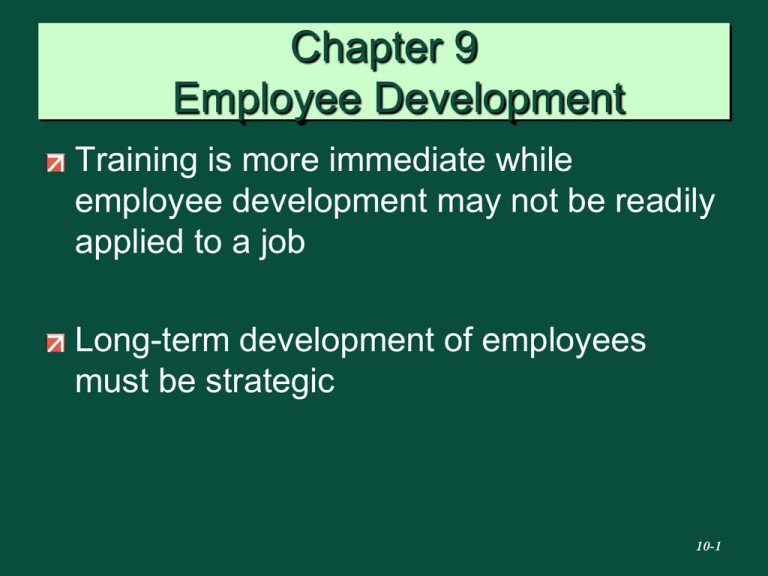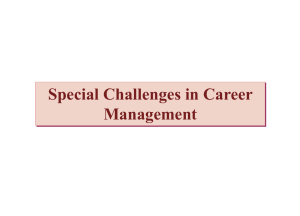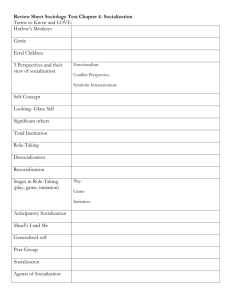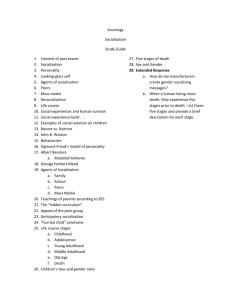
Chapter 9
Employee Development
Training is more immediate while
employee development may not be readily
applied to a job
Long-term development of employees
must be strategic
10-1
Development refers to formal education,
job experiences, relationships, and
assessments of personality and abilities
that help employees perform effectively in
their current or future job and company.
10-2
Comparison Between
Training and Development
10-3
Formal Education
Formal education programs include:
– off-site and on-site programs designed
specifically for the company’s employees
– short courses offered by consultants or
universities
– executive MBA programs
– university programs in which participants
actually live at the university while taking
classes
10-4
Motorola Corporate University
Well established corporate university in
U.S. and other countries.
Cutbacks have impacted corporate
university offerings.
Based in strategic objectives and ranges
from e-learning to classroom settings.
Developed Six Sigma in 1986 as quality improvement system and has
provided training to other corporations.
Offers training to suppliers and partners.
10-5
Established in 1993
Based in strategic initiative to implement
corporate objectives into local facilities
- implement marketing to compete locally
- continue innovative products
Leadership training, emerging business, etc.
Primarily offered to management employees
Supported through R&D and spending
“Before courses began, Motorola did extensive research and analysis to
determine what techniques and skills the three levels require. Motorola
University has since trained several thousand local managers.”
McGraw-Hill/Irwin
©2008 The McGraw-Hill Companies, All Rights Reserved
Xerox Corporate Sponsorship
Xerox Innovation Centre
$100,000 Grant from Xerox to Penn State to build an
innovation center
Provides students with opportunities to develop software
applications and gain experience
From Penn State Intercom, 2003
10-7
Assessment involves collecting
information and providing feedback
to employees about their behavior,
communication style, or skills
10-8
Popular Assessment Tools
Myers-Briggs Type
Indicator®
(MBTI)
Assessment Center
Benchmarks
Performance
Appraisals and
360-Degree Feedback
Systems
10-9
Assessment Tools:
Assessment Center
A process in which multiple raters or
evaluators evaluate employees’
performance on a number of exercises
–usually held at an off-site location
–used to identify if employees have the abilities,
personality, and behaviors for management
jobs
–used to identify if employees have the
necessary skills to work in teams
10-10
Examples of Skills Measured by
Assessment Center Exercises
10-11
Assessment Tools:
Performance Appraisals
The process of measuring employees’
performance
Approaches for measuring performance:
– ranking employees
– rating work behaviors
– rating the extent to which employees have desirable
traits believed to be necessary for job success (e.g.,
leadership)
– directly measuring the results of work performance
(e.g., productivity)
10-12
How Job Experiences are Used for
Employee Development
Promotion
Enlargement of
Current
Transfer
Job Rotation
(Lateral Move)
(Lateral Move)
Job
Experiences
Downward
Move
Temporary
Assignment ,
Projects, and
volunteer
work
10-13
Interpersonal Relationships
Employees can also develop skills and
increase their knowledge about the
company and its customers by interacting
with a more experienced organizational
member
Two types of interpersonal relationships
used to develop employees:
– mentoring
– coaching
10-14
Characteristics of Successful Formal
Mentoring Programs (1 of 2)
Mentor and protégé participation is voluntary
– relationship can be ended at any time without fear of
punishment
Mentor-protégé matching process does not limit
the ability of informal relationships to develop
Mentors are chosen on the basis of:
– their past record in developing employees
– willingness to serve as a mentor
– evidence of positive coaching, communication, and
listening skills
10-15
Characteristics of Successful Formal
Mentoring Programs (2 of 2)
The purpose of the program is clearly
understood
The length of the program is specified
A minimum level of contact between the mentor
and protégé is specified
Protégés are encouraged to contact one another
to discuss problems and share successes
The mentor program is evaluated
Employee development is rewarded
10-16
Benefits of
Mentoring Relationships (1 of 2)
Mentors provide
– career support
– psychosocial support
Benefits for protégés:
– skill development
– higher rates of promotion
– larger salaries
– greater organizational influence
10-17
Benefits of
Mentoring Relationships (2 of 2)
Provide opportunities for mentors to:
– develop their interpersonal skills
– increase their feelings of self-esteem and worth
to the organization
– gain knowledge about important new scientific
developments in their field
10-18
Coaching Relationships
Coach – a peer or manager who works with
employees to motivate them help them develop
skills provide reinforcement and feedback
The best coaches are:
–
–
–
–
empathetic
supportive
practical
self-confident
They also do not appear to know all the answers
10-19
C
h
a
p
t
e
r
Special Issues
in Training and
Employee
Development
10
McGraw-Hill/Irwin
©2008 The McGraw-Hill Companies, All Rights Reserved
Trainers are often forced to deal with a
wide variety of important issues that fall
outside the traditional discussion of the
components of instructional system
design.
10-21
Training Issues Resulting from the
External Environment:
Legal Issues
Welfare-to-Work
Programs
School-to-Work
Transition
Cross-Cultural
Preparation
Managing Work
Force Diversity
10-22
Relationship Between Training
Methods and Training Rigor
10-23
Managing Work Force Diversity
Managing diversity involves creating an
environment that allows all employees to
contribute to organizational goals and
experience personal growth
This includes:
– access to jobs
– fair and positive treatment of all employees
10-24
Goals of Diversity Training
To eliminate values, stereotypes, and
managerial practices that inhibit
employees’ personal development
To allow employees to contribute to
organizational goals regardless of their
race, age, physical condition, sexual
orientation, gender, family status, religious
orientation, or cultural background
10-25
How Managing Cultural Diversity Can
Provide Competitive Advantage
10-26
Cycle of Disillusionment: Results from Managing
Diversity Through Adherence to Legislation
10-27
Diversity Training Programs (1 of 3)
Diversity training – training designed to
change employee attitudes about diversity
and/or developing skills needed to work with
a diverse work force
Diversity training programs differ according to
whether attitude change or behavior
change is emphasized
10-28
Diversity Training Programs (2 of 3)
Attitude Awareness and Change Programs
– Focus on increasing employees’ awareness of
differences in cultural and ethnic backgrounds,
physical characteristics, and personal characteristics
that influence behavior toward others
– The assumption is that by increasing their awareness
of stereotypes and beliefs, employees will be able to
avoid negative stereotypes
10-29
Diversity Training Programs (3 of 3)
Behavior-Based Programs
– focus on changing the organizational policies and
individual behaviors that inhibit employees’ personal
growth and productivity
– one approach is to identify incidents that discourage
employees from working up to their potential
– another approach is to teach managers and
employees basic rules of behavior in the workplace
– cultural immersion is also used
10-30
Characteristics of Successful
Diversity Efforts (1 of 2)
Top management provides resources,
personally intervenes, and publicly advocates
diversity
The program is structured
Capitalizing on a diverse work force is defined
as a business objective
Capitalizing on a diverse work force is seen
necessary to generate revenue and profits
The program is evaluated
Manager involvement is mandatory
10-31
Characteristics of Successful
Diversity Efforts (2 of 2)
The program is seen as a culture change, not
a one-shot program
Managers and demographic groups are not
blamed for problems
Behaviors and skills needed to successfully
interact with others are taught
Managers are rewarded on progress toward
meeting diversity goals
10-32
School-to-Work Transition
School-to-work transition programs – combine
classroom experiences with work experiences to
prepare high school students for employment
School-to-Work Opportunities Act – encourages
partnerships between educational institutions,
employers, and labor unions
– every school-to-work system required to include workbased learning, school-based learning, and activities that
match students with employers
10-33
Training’s Role in Welfare-to-Work
Programs
There are two methods for training welfare
recipients:
– the first model involves government agencies
referring welfare recipients to a companysponsored training program subsidized with
money and tax credits from the government
– the second method is for state and local
governments to provide life and skills training
directly to welfare recipients
10-34
Training Issues Related to Internal Needs of the
Company
Basic Skills Training
Melting the Glass
Ceiling
Joint UnionManagement
Programs
Succession Planning
Training and Pay
Systems
Developing Managers
with Dysfunctional
Behaviors
10-35
Joint Union-Management Programs
Provide a wide range of services designed to
help employees learn skills that are directly
related to their job
Develop skills that are “portable” – i.e., valuable
to employers in other companies or industries
Both employers and unions contribute money to
run the programs and both oversee their
operation
10-36
The Succession Planning Process
Identify what positions are included in the plan
Identify the employees who are included in the
plan
Develop standards to evaluate positions
Determine how employee potential will be
measured
Develop the succession planning review
Link the succession planning system to other
human resource systems
Determine what feedback is provided to
employees
10-37
Developing Managers with
Dysfunctional Behaviors
Managerial behaviors which cause an otherwise
competent manager to be a “toxic” or ineffective
manager:
–
–
–
–
–
–
insensitivity to others
inability to be a team player
arrogance
poor conflict-management skills
inability to meet business objectives
inability to change or adapt during a transition
Specifically designed programs - Individual
Coaching for Effectiveness (ICE) program
10-38
Training and Pay Systems
Training is increasingly linked to
employees’ compensation
– skill-based pay systems
– knowledge-based pay systems
Employees’ pay is based primarily on the
knowledge and skills they possess rather
than the knowledge or skills necessary to
perform the current job
10-39
Chapter 11
Career Management
Career management is the process
through which employees:
–become aware of their own interests, values,
strengths, and weaknesses
–obtain information about job opportunities
within the company
–identify career goals
–establish action plans to achieve career goals
10-40
Career Management and Career
Motivation (1 of 2)
Career motivation refers to:
– employees’ energy to invest in their careers
– their awareness of the direction they want their careers
to take
– the ability to maintain energy and direction despite
barriers they may encounter
Career motivation has three aspects:
– career resilience
– career insight
– career identity
10-41
Career Management and Career
Motivation (2 of 2)
Career resilience – the extent to which
employees are able to cope with problems that
affect their work
Career insight involves –
– how much employees know about their interests, skill
strengths, and weaknesses
– the awareness of how these perceptions relate to their
career goals
Career identity – the degree to which
employees define their personal values
according to their work
10-42
What Is A Career? (1 of 2)
The individual sequence of attitudes and
behavior associated with work-related
experiences and activities over the span of the
person’s life
Four different meanings applied to the concept of
careers:
–
–
–
–
as an advancement
as a profession
a lifelong sequence of jobs
a lifelong sequence of role-related experiences
10-43
What Is A Career? (2 of 2)
Traditional Career
– sequence of positions held within an occupation
– context of mobility is within an organization
– characteristic of the employee
Protean Career
– frequently changing based on changes in the
person and changes in the work environment
– employees take major responsibility for managing
their careers
– based on self-direction with the goal of
psychological success in one’s work
10-44
Comparison of Traditional Career
and Protean Career
10-45
A Model of Career Development
Career development – the process by which
employees progress through a series of stages
Each stage is characterized by a different set of
developmental tasks, activities, and relationships
Career development models:
– life-cycle models
– organization-based models
– directional pattern model
10-46
A Model of Career Development
10-47
Components of the Career
Management Process (1 of 2)
Self-assessment
–use of information by employees to determine
their career interests, values, aptitudes, and
behavioral tendencies
–often involves psychological tests
Reality check
–information employees receive about how the
company evaluates their skills and knowledge
and where they fit into company plans
10-48
Components of the Career
Management Process (2 of 2)
Goal setting
–the process of employees developing shortand long-term career objectives
–usually discussed with the manager and
written into a development plan
Action planning
–employees determining how they will achieve
their short- and long-term career goals
10-49
Shared Responsibility:
Roles in Career Management
10-50
Managers’ Role in Career Management
10-51
Characteristics of Successful Career
Discussions
10-52
Evaluating Career Management
Systems
Career management systems need to be
evaluated to ensure that they are meeting the
needs of employees and the business
Two types of outcomes can be used to evaluate:
– reactions of the customers (employees and
managers) who use the career management system
– results of the career management system
Evaluation of a career management system
should be based on its objectives
10-53
Chapter 12
Career Management Challenges
Supportive work-life culture – a
company culture that:
– acknowledges and respects family and life
responsibilities and obligations
– encourages managers and employees to
work together to meet personal and work
needs
Helping employees balance work and life,
benefits the business and employees’
personal lives
10-54
If companies do not help their
employees with their personal
lives, they may leave for jobs
with other companies in other
areas that do.
10-55
Special Challenges in Career Management
Dealing With
Older Workers
Socialization
and Orientation
Dual-Career
Paths
Coping With
Job Loss
Plateauing
Balancing Work
and Life
Work and Nonwork Policies
Skills
Obsolescence
10-56
Socialization and Orientation
Organizational socialization – the process by
which new employees are transformed into
effective members of the company
The purpose of orientation is to:
– prepare employees to perform their jobs effectively
– learn about the organization
– establish work relationships
10-57
Phases of the Socialization
Process
Anticipatory Socialization
Encounter
Settling In
10-58
What Employees Should Learn and
Develop through Socialization
10-59
Socialization and Orientation Programs
Play an important role in socializing employees
Effective socialization programs result in
employees having a strong commitment and
loyalty to the company
– This reduces turnover
Effective orientation programs include active
involvement of the new employee
Effective programs have peers, managers, and
senior co-workers actively involved
10-60
Dual-Career Paths
A career path is a sequence of job positions
involving similar types of work and skills that
employees move through in the company
For companies with professional employees, a
key issue is how to ensure that they feel they are
valued
The traditional career path model has limited
advancement opportunities for those in the
technical career path
10-61
Example of Dual-Career- Path System
10-62
Plateauing
Plateauing means that the likelihood of the
employee receiving future job assignments with
increased responsibility is low
Mid-career employees are most likely to plateau
Plateauing becomes dysfunctional when the
employee feels stuck in a job that offers no
potential for personal growth
Such frustration results in:
– poor job attitude
– increased absenteeism
– poor job performance
10-63
Reasons for Employees to Plateau
Discrimination based on, for example, age,
gender, or race
Lack of ability
Lack of training
Low need for achievement
Unfair pay decisions or dissatisfaction with pay
raises
Confusion about job responsibilities
Slow company growth resulting in reduced
development opportunities
10-64
Possible Remedies for Plateaued
Employees
Employee understands the reasons for
plateauing
Employee is encouraged to participate in
development activities
Employee is encouraged to seek career
counseling
Employee does a reality check on his or
her solutions
10-65
Skills Obsolescence
Obsolescence – a reduction in an employee’s
competence resulting from a lack of knowledge
of new work processes, techniques, and
technologies that have developed since the
employee completed her education
Not just a concern of technical and professional
occupations
– all employees are at risk
Obsolescence needs to be avoided if companies
are trying to become learning organizations
10-66
Factors Related to Updating Skills
Company Climate
Manager
• Provide Challenging Work Assignments
• Encourage Employees to Acquire New Skills
• Emphasis on Continuous
Learning
Updated
Skills
Peers
Reward System
• Discuss Ideas
• Sabbaticals
• Share Information
• Pay for New Ideas
• Pay for Employee Development
10-67
Types of Work-Life Conflict
Time-Based Conflict
Strain-Based Conflict
Behavior-Based Conflict
10-68
Outplacement Services
To prepare employees for layoffs and reduce the
potential negative effects, companies need to
provide outplacement services. Outplacement
services should include:
–
–
–
–
advance warning and explanation for a layoff
psychological, financial, and career counseling
assessment of skills and interests
job campaign services (e.g., résumé-writing
assistance)
– job banks
– electronic delivery of job openings, self-directed
career
10-69
Dealing With Older Workers
Age Discrimination in Employment Act
Meeting the needs of older workers
Pre-retirement socialization
Retirement
Early retirement programs
10-70
Early Retirement Programs
Early retirement programs offer employees
financial benefits to leave the company
To avoid costly litigation, companies need to
make sure that their early retirement programs
contain the following features:
– the program is part of the employee benefit plan
– the company can justify age-related distinctions for
eligibility for early retirement
– employees are allowed to voluntarily choose early
retirement
10-71
Chapter 13
McGraw-Hill/Irwin
©2008 The McGraw-Hill Companies, All Rights Reserved
New Technologies for Training
Delivery (1 of 2)
The use of online learning, mobile learning
(iPods), and other new technologies will
likely increase in the future because:
–cost of these new technologies will decrease
–companies can use technology to better
prepare employees to service customers and
generate new business
–training costs will be substantially reduced
through use of new technologies
10-73
New Technologies for Training
Delivery (2 of 2)
–technologies allow trainers to build into training
many of the desirable features of a learning
environment
–technology will allow training to be delivered to
contingent, decentralized employees in a
timely, effective manner
10-74
Virtual Work Arrangements
Critical feature of virtual work arrangements is
that location, organization structure, and
employment relationships are not limiting factors
Virtual work arrangements include:
– virtual teams
– telecommuting
Two training challenges:
– companies have to invest in training delivery methods
that facilitate digital collaboration
– teams and employees must be provided the tools
they need for finding knowledge
10-75
Criticisms of the Traditional Training
Design Model
A linear approach driven by subject-matter
experts
The Instructional System Design model uses a
rational, step-by-step approach that assumes
that the training content is stable
Given the accelerated demand for training to be
delivered just in time, traditional training takes
too long
10-76
Rapid Instructional Design (RID)
A group of techniques that allows training to be
built more quickly
Two important principles in RID:
– instructional content and process can be developed
independently of each other
– resources devoted to design and delivery of
instruction can be reallocated as appropriate
10-77
Intellectual Capital
Companies will increasingly seek ways to turn
employees’ knowledge (intellectual capital) into
a shared company asset
Trainers and the training department likely will:
– manage knowledge
– coordinate organizational learning
10-78
Embedded Learning
Embedded learning – learning that occurs on
the job as needed
It involves collaboration and nonlearning
technologies such as instant messaging
It is integrated with knowledge management
Embedded learning may become increasingly
prevalent in the future because:
– companies can no longer have employees attend
classroom instruction
– have employees spend hours on online learning that
is not directly relevant to their current job demands
10-79
Functional Areas and Applications of
Real-Time Extended Business:
Resource Management
Human Capital Development
Enterprise Resource Management
Employee Resource Management
Learning Management Systems
Product Management
Product Life-Cycle Management
Supply Chain Management
Work Force Management
Customer Relations Management
Collaborator Management
Structured Knowledge
Management
Instant Messaging
Collaborative Web-Conferencing
Process Management
Work Flow Management
Customer Analytics
Work Force Analytics
Business Process Management
10-80
Learning Management Systems (LMS)
(1 of 2)
Used to automate the administration of
online learning systems
Can help companies:
– reduce travel costs related to training
– reduce time for program completion
– increase employees’ accessibility to training
across the business
– provide administrative capabilities to track
program completion and course enrollments
10-81
Learning Management Systems (LMS)
(2 of 2)
Important for human capital management
Human capital management – integrates
training with the human resource function to
determine:
– how training dollars are spent, and
– how that expense relates to business dollars for the
company
Accomplished through a software system that
integrates all human resource management
activities with each other
10-82
Business Needs and Performance
(1 of 2)
Training departments will have to ensure
that they are seen as helping the business
functions to meet their needs
Requires a shift from training as the
solution to business problems to a
performance analysis approach
– involves identifying performance gaps or
deficiencies and examining training as one
possible solution for the business units (the
customers)
10-83
Business Needs and Performance
(2 of 2)
Ways that training departments will need to be
involved are:
– focusing on interventions related to performance
improvement
– providing support for high-performance work systems
– developing systems for training administration,
development, and delivery that reduce costs and
increase employees’ access to learning
Training departments’ responsibilities will
include a greater focus on systems that
employees can use for information on an asneeded basis
10-84
Training and Development from a
Change Model Perspective: (1 of 3)
Conditions necessary for new training or
development practices to be successfully
implemented:
– employees must understand the reasons for change
and agree with those reasons
– employees must have the skills needed to implement
the change
– employees must see that managers and other
employees in power positions support the change
– organizational structures such as compensation and
performance management systems must support the
change
10-85
Training and Development from a
Change Model Perspective: (2 of 3)
The process of change is based on the
interaction among four components of the
organization:
–
–
–
–
task
employees
formal organization arrangements
informal organization
Different types of change-related problems
occur depending on the organizational
component that is influenced by the change
10-86
Training and Development from a
Change Model Perspective: (3 of 3)
Four change-related problems need to be
considered for any new training practice:
– Resistance to change – managers’ and employees’
unwillingness to change
– Loss of control – change to managers’ and
employees’ ability to obtain and distribute valuable
resources such as data, information, or money
– Power imbalance – the ability to influence others.
Managers may lose the ability to influence employees
as employees gain access to databases and other
information
– Task redefinition – creates changes in managers’
and employees’ roles and job responsibilities
10-87
A Change Model
10-88
Methods to Determine Whether
Change is Necessary
Viewing training from a systems
perspective means that companies and
trainers need to understand both internal
and external environments
They need to understand the effectiveness
and efficiency of current training practices
They need to be aware of other
companies’ practices to ensure that their
training practices are the best possible
10-89
Organization Development:
Is a planned, systematic change process that
uses behavioral science knowledge and
techniques to improve companies’ effectiveness
by improving relationships and increasing
learning and problem-solving capabilities
Helps create a learning environment through
increased trust, confrontation of problems,
employee empowerment and participation,
knowledge sharing, work design, and
cooperation between groups, and through
allowing employees to maximize their skills and
grow
10-90
Change Management
Change management is the process of
ensuring that new interventions such as training
practices are accepted and used by employees
and managers
Four issues need to be addressed to facilitate
the change management process:
–
–
–
–
overcoming resistance to change
managing the transition to the new practice
shaping political dynamics
using training to understand new tasks
10-91
Change Management Steps
4. Using Training To
Explain New Tasks
3. Shaping Political
Dynamics
1. Overcoming
Resistance To Change
2. Managing The
Transition
10-92
Change Interventions
Survey Feedback
Process Consultation
Group Interventions
10-93








